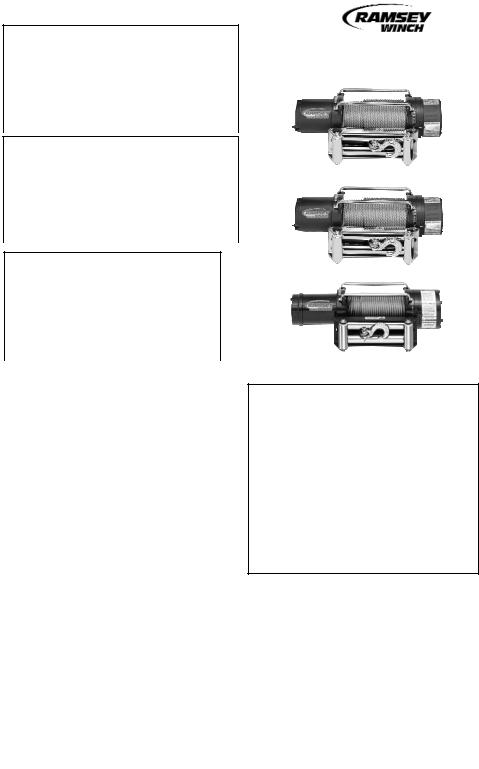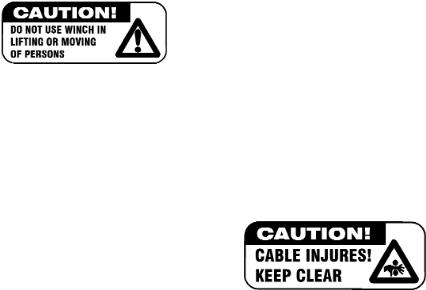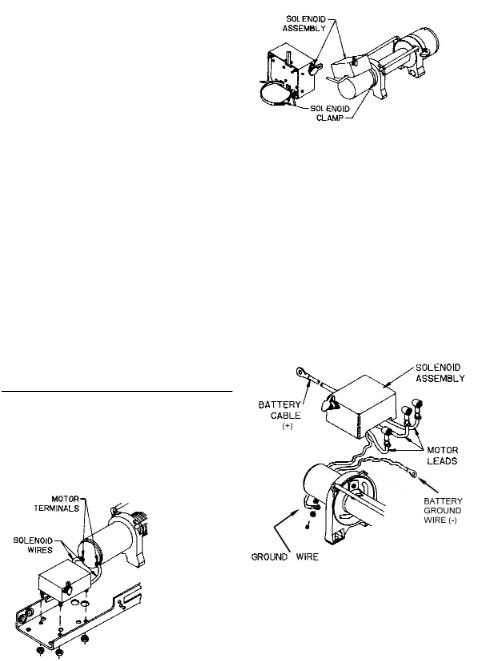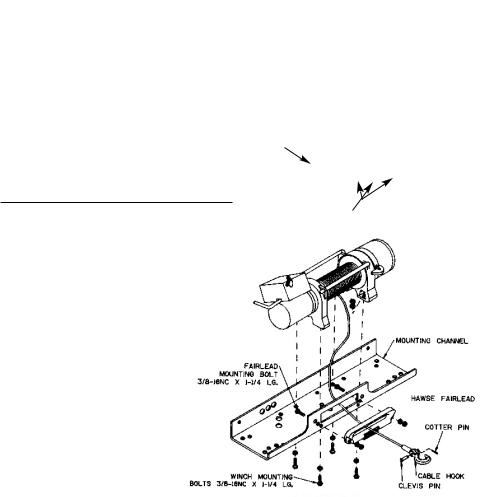Ramsey REP-6000, REP 8000, REP 9000 User Manual

REP 6000
PERFORMANCE FIRST LAYER OF CABLE |
|
CABLE DRUM CAPACITY |
|||||
|
|
|
|
|
|||
LINE PULL |
LINE SPEED |
CURRENT |
|
(1/4" (6 MM) DIA. CABLE) |
|||
(FPM) |
(AMPS) |
|
CUMULATIVE BY LAYER |
||||
|
|
|
|||||
(lbs) |
(kg) |
12V |
12V |
|
LAYER |
FT.* |
M* |
0 |
0 |
25 |
70 |
|
1 |
20 |
6 |
1,000 |
450 |
21 |
155 |
|
2 |
50 |
15 |
3,000 |
1,350 |
16 |
240 |
|
3 |
80 |
24 |
5,000 |
2,260 |
10 |
370 |
|
4 |
100 |
30 |
6,000 |
2,710 |
8 |
440 |
|
* DEPENDS ON CABLE BEING |
||
|
|
|
|
|
UNIFORMLY WOUND ONTO DRUM. |
||
|
|
|
|
|
|
|
|
REP 8000
PERFORMANCE FIRST LAYER OF CABLE |
|
CABLE DRUM CAPACITY |
|||||
LINE PULL |
LINE SPEED |
CURRENT |
|
(5/16" (8 MM) DIA. CABLE) |
|||
(FPM) |
(AMPS) |
|
CUMULATIVE BY LAYER |
||||
|
|
|
|||||
(lbs) |
(kg) |
12V |
12V |
|
LAYER |
FT.* |
M* |
0 |
0 |
18 |
60 |
|
1 |
15 |
4 |
2,000 |
900 |
15 |
150 |
|
2 |
40 |
12 |
4,000 |
1,810 |
12 |
220 |
|
3 |
70 |
21 |
6,000 |
2,710 |
9 |
310 |
|
4 |
95 |
28 |
8,000 |
3,620 |
6 |
420 |
|
* DEPENDS ON CABLE BEING |
||
|
|
|
|
|
UNIFORMLY WOUND ONTO DRUM. |
||
REP 9000
PERFORMANCE FIRST LAYER OF CABLE |
|
CABLE DRUM CAPACITY |
|||||||
|
|
|
|
|
|
|
|||
LINE PULL |
LINE SPEED |
CURRENT |
|
(5/16" (8 MM) DIA. CABLE) |
|||||
(FPM) |
(AMPS) |
|
CUMULATIVE BY LAYER |
||||||
|
|
|
|||||||
(lbs) |
(kg) |
12V |
24V |
12V |
24V |
|
LAYER |
FT.* |
M* |
0 |
0 |
33 |
25 |
97 |
35 |
|
1 |
15 |
4 |
2,000 |
900 |
17 |
15 |
180 |
75 |
|
2 |
40 |
12 |
4,000 |
1,810 |
13 |
11 |
260 |
110 |
|
3 |
70 |
21 |
6,000 |
2,710 |
11 |
9 |
335 |
140 |
|
4 |
95 |
28 |
9,000 |
4,070 |
8 |
7 |
420 |
175 |
|
* DEPENDS ON CABLE BEING |
||
|
|
|
|
|
|
|
UNIFORMLY WOUND ONTO DRUM. |
||
|
|
|
|
|
|
|
|
|
|
Ramsey performance data is compiled from actual winch testing
Congratulations
You have purchased the finest winch available in its service class. The REP 6000, REP 8000 and REP 9000 feature a highly efficient 3 stage planetary gear set. The REP 6000 and REP 8000 transmit torque from a permanent magnet D.C. motor, while the REP 9000 utilizes a series wound D.C. motor. A safe positive clutch allows free spooling for quick cable deployment. An automatic load holding brake is designed to hold the full rated capacity of the winch. It was designed and manufactured to provide you with the utmost in utility. As with any device that combines power and movement in its use, there are dangers if improperly used. At the same time, there are easier and faster ways for getting the job done if certain precautions are taken first. Please read this manual carefully. It contains useful ideas in obtaining the most efficient operation from your Ramsey Winch and safety procedures you need to know
Ramsey Winch Company
OWNER’S MANUAL
Front Mount Electric Winches
Model REP 6000
Model REP 8000
Model REP 9000 |
|
Contents |
|
Safety Precautions .............................. |
2 |
Tips for Safe Operation........................ |
2 |
Techniques of Operation ...................... |
3 |
Installation ...................................... |
4-5 |
Electrical Connections & Operations ....8 |
|
Maintenance ...................................... |
8 |
Operating Instructions ........................ |
9 |
Trouble Shooting Guide .................... |
10 |
Winch Parts List .......................... |
11-15 |
Warranty.............................. |
Back Cover |
before beginning use. When you follow our guidelines for operation, your Ramsey Winch will give you many years of satisfying service. Thank you for choosing Ramsey. You will be glad you have one working for you.
Please Note: Ramsey REP6000, REP8000 and REP9000 Series winches are designed for front mount vehicle use. The winches are not designed for and should not be used in industrial applications (car haulers/carriers, wreckers, hoisting, etc.), and Ramsey does not warrant them to be suitable for such use. Ramsey makes a separate, complete line of winches for industrial/commercial use. Please contact the factory for further information.
CAUTION: Read and understand this manual before installation and operation of winch. See Safety Precautions.

Safety Precautions To Guard Against Possible Injury…
A minimum of five wraps of cable around the drum barrel is necessary to hold the rated load. Cable clamp in not designed to hold the load.
A.Keep yourself and others a safe distance to the side of the cable when pulling under load.
B.Don't step over a cable, or near a cable under load.
C.Use supplied hook strap when handling hook for spooling wire rope.
D.Don't move the vehicle to pull a load on the winch cable. This could result in cable breakage.
E.Use a heavy rag or gloves to protect hands from burrs when handling winch cable.
F.Apply blocks to wheels when vehicle is on an incline.
G.Winch clutch should be disengaged when winch is not in use and fully engaged when in use.
H.Modification, alteration or deviation to the winch should only be made by Ramsey Winch Company.
I.Keep the duration of your pulls as short as possible. If the motor becomes uncomfortably hot to the touch, stop and let it cool for a few minutes. Do not pull more than one minute at or near rated load. Do not maintain power to the winch if the motor stalls. Electric winches are for intermittent usage and should not used in constant duty applications.
J.Disconnect the remote control switch from the winch when not in use. A Ramsey Part No. 282053 safety on-off switch in your vehicle is recommended.
K.Note: Do not use winch in hoisting applications due to required hoist safety factors and features.
L.Do not exceed maximum line pull ratings shown in tables. Shock loads must not exceed these ratings.
M.To respool correctly, it is necessary to keep a slight load on the cable. This is accomplished by (wearing gloves) holding the cable with one hand and the remote control switch with the other, starting as far back and in the center as you can, walking up keeping load on the cable as the winch is powered in. Do not allow the cable to slip through your hand and do not approach the winch too closely. Turn off the winch and repeat the procedure until all the cable except a few feet is in. Disconnect the remote control switch and finish spooling in cable by rotating the drum by hand with clutch disengaged. On hidden winches, spool in cable under power using supplied hook strap.
Tips for Safe Operation
Don't underestimate the potential danger in winching operations. Neither should you fear them. Do learn the basic dangers and avoid them.
The uneven spooling of cable, while pulling a load, is not a problem, unless there is cable pileup on one end of drum. If this happens, reverse the winch to relieve the load and move your anchor point further to the center of the vehicle. After the job is done you can unspool and rewind for a neat lay of the cable.
Store the remote control switch inside your vehicle where it will not become damaged. Inspect it before you plug it in.
When ready to begin spooling in, plug in remote control switch with clutch disengaged. Do not engage clutch with motor running.
Never connect the hook back to the cable. This causes cable damage. Always use a sling or chain of suitable strength as shown in the illustrations.
Observe your winch while winching, if possible, while standing at a safe distance. If you use vehicle drive to assist, stop and get out every few feet to assure the cable is not piling up in one corner. Jamming cable can break your winch.
Do not attach tow hooks to winch mounting apparatus. They must attach to vehicle frame.
2

When double lining during stationary winching, the winch hook should be attached to the chassis of the vehicle.
Since the greatest pulling power is achieved on the innermost layer of your winch, it is desirable to pull off as much line as you can for heavy pulls (remember, you must leave 5 wraps min. on the drum). If this is not practical, use a snatch block and double line arrangement (see illustration).
Neat, tight spooling avoids cable binding, which is caused when a load is applied and the cable is pinched between two others. If this happens, alternately power the winch in and out a few inches. Do not attempt to work a bound cable under load; free by hand.
Winches equipped with cable guide fairleads can pull from several directions. Pull from an angle only to straighten up the vehicle-otherwise you can damage structural members or other parts of your vehicle and cause excess cable buildup on one end of the winch drum.
Techniques of Operation
The best way to get acquainted with how your winch operates is to make a few test runs before you actually need to use it. Plan your test in advance. Remember you hear your winch as well as see it operate. Get to recognize the sound of light steady pull, a heavy pull, and sounds caused by load jerking or shifting. Soon you will gain confidence in operating your winch and its use will become second nature with you.
Your winch will not only pull your vehicle up or ease your vehicle down a steep grade, it will also pull another vehicle or a load while your vehicle is anchored in a stationary position. The following sketches show you a few techniques.
When pulling a heavy load, place a blanket, jacket or tarpaulin over the cable five or six feet from the hook. It will slow the snap back in the event of a broken cable. Also open the vehicle hood for additional protection.
For basic self-recovery, anchor to a tree or heavy rock. When anchoring to a tree, always use a tree trunk protector.
Stakes driven in solid earth and chained together make a good anchor point for self-recovery when no solid anchor point is available.
For a direct pull of 2000 lbs., hitch truck to a tree or solid anchor, and take out of gear.
For a solid anchor, bury a log with earth or sand or place it in a deep ravine.
To double the pull, use 2-part line with snatch block and tie off to chassis. Take out of gear.
Use the vehicle wheel power to help the winch, but don't overtake the winch line. Plan your pull. You can't always hook up and pull out in one step. Examine all the areas for anchoring possibilities as well as leverage situations, direction and goal.
3

Installation
The winches shown in this owner's manual are solely and exclusively designed for vehicle mounted, non-industrial applications. All other applications will void warranty.
Note: For specific bull-bar applications, the shifter lever on the winch may need to be repositioned. Refer to pages 6-7 for instructions in how to do this.
It is very important that the winch be mounted on a flat surface so that the three major sections (the motor end, the cable drum and the gear housing end) are properly aligned. It is recommended that Ramsey kits be used to mount the winch. They are designed to align the winch and distribute up to the full rated load evenly, to avoid possible damage to the winch or vehicle. Note: If recommended mounting is not used, a kit of equal design must be used.
Also available for mounting the REP winches are winch mounting channels, short length (23.63") #408052 (black), medium length (30.00")
#408120 (black) and long length (36.00") #408101 (black). It is recommended that a Ramsey mounting channel be used in all nonRamsey mountings.
Note: See the following separate sections for attaching the wiring to the motor and solenoid for the REP 6000/8000, REP 9000 12V, and REP 9000 24V models. The combined installation instructions resume on the following page.
REP 6000/8000
When mounting winch, attach solenoid wires to motor terminals at end of motor. TIGHTEN NUTS ON MOTOR TERMINALS SECURELY (see FIGURE 1). Attach solenoid to mounting holes at end of long channel (see FIGURE 1) or use solenoid
FIGURE 1
clamp to attach solenoid assembly to winch motor (see FIGURE 2). Position solenoid at about a 45° angle for clearance of lower winch guard tube of kit. TIGHTEN CLAMP SECURELY.
FIGURE 2
REP 9000 12V
When mounting winch, connect labeled motor leads coming from solenoid assembly to appropriately marked motor terminals. TIGHTEN NUTS ON MOTOR TERMINALS SECURELY (see FIGURE 3). Attach solenoid ground wire to grounding bolt located at bottom of motor (Battery ground wire is already installed to grounding bolt on motor.)
Use solenoid clamp, as shown in FIGURE 2, to secure solenoid assembly to winch motor. If installing in combo mounting kit, position at about a 45° angle for clearance of lower winch guard tube in kit. Be sure that clamp is clear of motor terminals at bottom of motor. TIGHTEN CLAMP SECURELY.
FIGURE 3
4

REP 9000 24V
When mounting winch, connect labeled motor leads coming from solenoid assembly to appropriately marked motor terminals. TIGHTEN NUTS ON MOTOR TERMINALS. Attach solenoid ground to #10 Capscrew located on vertical surface of motor end bearing (See FIGURE 4). Use solenoid clamp, as shown in FIGURE 2, to secure solenoid assembly to winch motor. If installing in combo mounting kit, position at about a 45° angle for clearance of lower winch guard tube in kit. Be sure that clamp is clear of motor terminals at bottom of motor. TIGHTEN CLAMP SECURELY.
Attach fairlead to channel using hardware furnished with winch (see FIGURE 5). Attach winch to channel. Place (4) flat washers and nuts into pockets of winch mounting feet and thread capscrews with lock washers through mounting holes in channel and into hardware in winch feet.
Substitution of attaching hardware items (bolts, nuts or washers) different from those supplied with your winch and mounting kit can lead to failure causing damage or serious injury (use SAE grade 5 bolts or better and torque to 34 ft. lbs.)
Place end of drum cable through fairlead and attach cable hook. Use clevis pin and cotter pin (see FIGURE 5).
Hole for
Solenoid
Ground Wire
Bolt
Motor
Terminals
FIGURE 4
FIGURE 5
5
